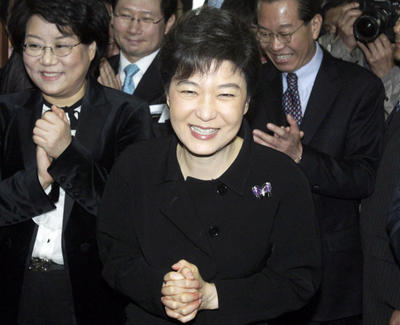The Saenuri Party, which controlled 60 per cent of seats before the election, managed just to keep its majority in the national assembly by winning 152 of the parliament’s 300 seats. The party had feared a crushing defeat because President Lee Myung-bak’s approval rating remains low at around 20 per cent and successive bribery scandals have also damaged the party’s reputation.
But after leading the Saenuri Party to a surprising victory in the parliamentary elections, the party’s leader, Geun-hye Park, now stands a good chance of becoming South Korea’s next president. It would make her the first democratically elected female president in South Korea, an economically vibrant but largely male-dominated society. Park’s new platform of robust welfare-oriented policies helped to move the traditionally conservative party slightly to the left. This new focus was an appeal to voters otherwise fed up with the nation’s jobless recovery following the global financial crisis.
The presence of a clear presidential front runner and a centre-right vision for the country’s future seems to have helped the Saenuri Party win more seats than the opposition in South Chungcheong and Gangwon provinces, where the opposition had been successful in the last parliamentary and local elections.
Following the 2008 national assembly elections, a new version of regionalism seemed to have emerged throughout the country. The new regionalism contrasts voter behaviour between Seoul and other metropolitan areas with the less-urbanised areas. On the other hand, the old regionalism highlighted the parties’ regional strongholds. The result of the April 2012 election surprised many because it seems to suggest that the old version of regionalism has reappeared, with both the Saenuri Party and the Democratic United Party taking almost all the seats in their respective strongholds.
The degree of influence that social media exerted on voting behaviour also seems to be divided between cities and non-cities. Statistics show that around 60 per cent of people who use these services live in Seoul and other metropolitan areas and they are predominantly younger voters, often with liberal leanings. This indicates that South Korea’s metropolitan areas should have been ripe for the opposition parties to take advantage of strong anti-government sentiment. While the opposition parties did gain 62 per cent of seats allocated to these regions, it was not enough for them to take full control of the national assembly. Seoul and other metropolitan areas hold 46 per cent of the 246 seats allocated to local districts across the country, but the opposition parties won only 4 seats of the 67 allocated to the southeastern Youngnam regions. The Saenuri Party, on the other hand, swept up the other 63 seats in this area, which represents 50 per cent of the seats the party acquired in the local districts.
The liberal opposition Democratic United Party secured 127 seats; its coalition partner, the left-leaning United Progressive Party, won 13 seats. The election results were particularly disappointing for the opposition coalition, which sought to win a comfortable majority in the national assembly. The governing party already suffered a setback in local elections two years ago, and again in the 2011 by-election for Seoul’s mayor. Furthermore, the April election was largely regarded as a referendum on President Lee Myung-bak and the governing party. The opposition parties expected to ride a liberal, anti-government wave to victory in the parliamentary elections, yet their failure to do so turned the result into an unwelcome surprise. One of the main explanations for the defeat is the opposition’s perceived lack of vision for the future. Many South Koreans believe the opposition relied on the president’s low approval rating to win them votes, without developing their own policy alternatives.
Voter turnout for the parliamentary election was 54.3 per cent — an 8.2 percentage point increase on the 2008 election, which had the lowest turnout for national assembly elections since democratisation in 1988. Many academics are paying special attention to South Korea’s voting patterns this year to determine how the traditional cleavage structures of regionalism change across generational, class and ideology lines. Looking forward to the presidential election in December, we may get some further clues about the possible realignment of the relationship between parties and their traditional regional support base.
Myoung-ho Park is Associate Professor at the Department of Political Science, Dongguk University, Seoul.

